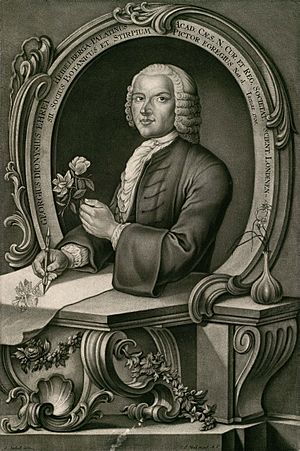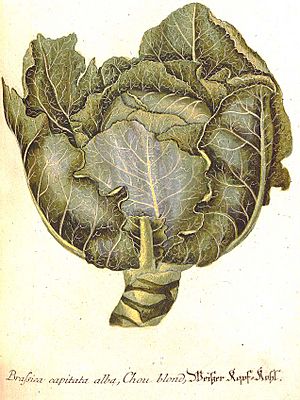Georg Dionysius Ehret facts for kids
Quick facts for kids
George Dionysius Ehret
|
|
|---|---|
 |
|
| Born | 30 January 1708 |
| Died | 9 September 1770 |
| Nationality | German |
| Known for | botanical illustrations |
Georg Dionysius Ehret (born January 30, 1708 – died September 9, 1770) was a talented German artist. He is famous for his amazing drawings of plants, known as botanical illustrations. He also studied insects.
Ehret's Amazing Life
Georg Ehret was born in Germany. His father, Ferdinand Christian Ehret, was a gardener and a good artist too. Georg started his career as a gardener's helper near Heidelberg. He grew up to become one of the most important plant artists in Europe.
His first drawings were made with Carl Linnaeus and George Clifford. This happened between 1735 and 1736. George Clifford was a rich Dutch banker. He was also a leader of the Dutch East India Company. Clifford loved plants and had a very large collection of dried plants, called a herbarium.
Because he was wealthy, Clifford could hire great scientists like Linnaeus. He could also hire artists like Ehret. They all worked together at Clifford's home, Hartecamp. This estate was in Heemstede, near Haarlem in the Netherlands. In 1738, they created a famous book called Hortus Cliffortianus. It was a masterpiece of early plant literature.
After some challenges, Ehret moved to England. There, important people like Sir Hans Sloane and the Duchess of Portland helped him. A writer named Wilfrid Blunt said that Ehret drew exactly what he saw. But he also made the colors and designs of the flowers look beautiful.
Ehret was a very popular artist. His plant paintings were used in books by Mark Catesby. These books showed the plants and animals of the New World. His drawings from a series called Plantae et Papiliones Rariores (1748-1759) were even used on Chelsea porcelain.
He also drew many amazing plants for Philip Miller. These plants were grown at the Chelsea Physic Garden. In 1768, Ehret was at the top of his career. A young plant scientist named Joseph Banks came back from Labrador and Newfoundland. He had many plant samples. Banks asked Ehret to make very detailed paintings of them on vellum. Vellum is a special, smooth material made from animal skin.
You can find Ehret's original artwork in many places. Some are at the Natural History Museum in London. Others are at the Royal Botanic Gardens, Kew, and The Royal Society in London. You can also see them at the Victoria and Albert Museum. More of his works are in libraries and institutes in Germany and the United States.
A type of plant, called Ehretia, was named after him to honor his work.
Ehret's Famous Works
Ehret created many important books and illustrations during his life:
- Hortus nitidissimis (in 3 volumes, 1750-1786)
- The Natural History of Barbados, by Griffith Hughes, 1750.
- Plantae et papiliones rariores. This book was published in parts from 1748 to 1759. It had eighteen large plates. Ehret himself engraved and colored these plates by hand. Most of them show one or more types of plants with butterflies.
- Illustrations for Plantae selectae by Christoph Jakob Trew.
- Illustrations for "The Gardeners Dictionary" by Philip Miller. These were for the Seventh Edition (1756-1759) and the Eighth Edition (1768). There were 16 plates.
- Illustrations for Hortus Kewensis by William Aiton (in 3 volumes, 1789).
- Illustrations for Patrick Browne's amazing book The Civil and Natural History of Jamaica. This book was published in three parts in 1756.


